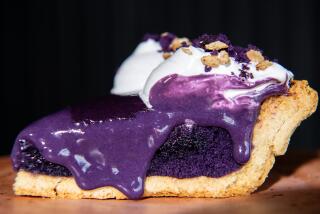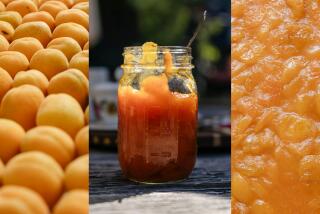Seasonal Fruit : The Berries of Summer
- Share via
School is out for the summer and strawberries signal the beginning of berry season. I pack a picnic lunch, load my family in the car and head for the you-pick fields.
I caution everyone not to pick as many berries as last year, reminding them how long it took me to clean and make jam out of last year’s batch. I say this every year, and every year when we reach the fields, the berries are such a bright red and so good to eat that we end up picking more than we can possibly eat in a year’s time.
Two hours later we carry our berry flats to the weighing stand, pay up and drive off. Dusty and berry-stained, we head for our favorite picnic spot to stretch out on the grass. Those berries not already eaten are tucked away in the coolers.
When we arrive home in the evening, everyone disappears while I begin to sort and clean the berries. I slice them for freezing, and with the others I make jam, alternatively tossing one in the pot, one in my mouth. The doors are open, the kitchen is warm and sticky and the baseball game is on. As midnight approaches, I promise myself that next year we won’t pick so many berries.
Bowls of berries, baskets of berries, fields of berries--the summer brings us a bounty of berries and happily we eat them all. We eat them fresh or cook them into pies, cobblers and jams. They are intertwined with memories and occasions throughout the summer: Fourth of July means strawberry shortcake, Labor Day brings blueberry cobbler, and birthdays and gatherings in between mean lots of berry pies.
My best friend’s father loved to pick wild blackberries. It was his hobby and he took it quite seriously, even though the season lasted only two to three weeks. He had a favorite patch, though he never told anyone where it was. He would take a clean two-pound shortening can, punch two holes in it and attach a wire handle. He’d set out in the morning to patiently gather enough of these jewel-like berries to make a pie.
Back at the house he would oversee the cleaning of the berries, coaching his young daughter all the while, “Just a slight drizzle of water when you wash--if you use too much you’ll wash away the juice.”
Patiently the stems were removed, each berry picked clean, and then it would be time to make a pie. His rules for the pie were few but strict: Never use too much flour and never serve it with ice cream. He was a purist.
There is evidence that berries were eaten and savored as long ago as 5000 B.C. By the early 17th Century, berries were cultivated in kitchen gardens in England. Strawberries, in particular, were a favorite subject of European artists, who painted them bright red, plump and ready to eat.
In the New World, the variety of wild berries available delighted the early settlers. They found wild strawberries, blueberries, blackberries, gooseberries and cranberries, which they ate both fresh and cooked. The Native Americans taught them how to preserve them by drying them in the sun. High in vitamins and minerals, berries became an important part of their diet.
The invention of canning early in the 19th Century led to the gradual near-elimination of the local growers markets. Farmers could now grow berries in larger quantities for people who could preserve (rather than immediately have to consume) them. The development of the railroads further aided the growth of the commercial berry market. Once limited to selling their goods near where they lived, farmers were now able to ship larger quantities across greater distances. It was also around this time that plant breeders and botanists began hybridizing new varieties of cultivated berries, improving the size and quality, making them better suited for growing on a commercial scale.
The Gold Rush of 1849 expanded the commercial berry business further. As huge numbers of pioneers flooded the West, horticultural centers on the northern and central coasts of California were established. Later, when the population migrated into the Pacific Northwest, the Willamette Valley in Oregon became a central growing region for strawberries, blackberries, raspberries, gooseberries and currants. These Western regions--Hood River, Ore., and Watsonville, Calif., in particular--continue to produce some of the finest berries.
Today, we enjoy a wide choice of beautiful berries. Although berries grow best in certain regions in the United States, thanks to refrigerated shipping they can be enjoyed all around the country. In the summer, you can gather berries from your own garden, seek out the nearest you-pick farm, visit a nearby farmers market or fill your basket at your own secret berry patch.
*
This patriotic dessert is beautiful and luscious, celebrating summer in all its glory. It’s sheer berries from top to bottom, layered with creamy clouds of parfait cream. Parfait cream is a versatile companion for all berries.
FOURTH OF JULY PARFAIT
1/2 pound cream cheese, at room temperature
6 tablespoons powdered sugar
1 cup whipping cream
1 to 2 teaspoons fresh lemon juice
1 pint fresh blueberries, stemmed and lightly seasoned to taste with granulated sugar
1 pint fresh red raspberries, lightly seasoned to taste with granulated sugar
Fresh mint leaves or lemon balm
Whip cream cheese and powdered sugar in medium bowl until fluffy. Slowly add whipping cream, little at time, and continue beating until cream is incorporated and mixture is fluffy. Add lemon juice to taste.
To assemble, use parfait glasses, tall wine glasses or champagne flutes. Spoon 1 inch of blueberries into glass, top with dollop of parfait cream and then spoon 1 inch of raspberries on top, followed by another dollop of parfait cream. Repeat layers. Garnish with mint leaves. Makes 6 to 8 servings.
Each serving contains about:
362 calories; 131 mg sodium; 96 mg cholesterol; 29 grams fat; 25 grams carbohydrates; 5 grams protein; 2.43 grams fiber.
*
Clafouti is a traditional French dessert made with cherries. This variation made with cranberries gives it a New England twist.
CRANBERRY CLAFOUTI
3 cups fresh or frozen cranberries
1 1/2 cups cranberry juice or water
6 eggs
1 cup plus 2 tablespoons granulated sugar
6 tablespoons flour
1 cup plus 2 tablespoons milk
3/4 cup whipping cream
3/4 teaspoon vanilla
1/8 teaspoon ground cinnamon
Whipped cream for garnish
Cook cranberries in cranberry juice in heavy saucepan over medium-low heat 5 minutes. Strain berries, reserving juice. Set aside. Return juice to saucepan and bring to boil. Continue cooking until juice is reduced to 1/4 cup, about 7 minutes.
Combine eggs, granulated sugar, flour, milk, cream and vanilla in bowl of food processor or mixer and mix about 1 minute. Pulse or stir in reduced 1/4 cup cranberry juice.
Spread cranberries over bottom of buttered 9-inch-square baking dish. Pour batter over berries. Sprinkle with cinnamon. Bake at 400 degrees until top is puffed and golden, 40 to 45 minutes. Serve hot or warm. Top with whipped cream. Makes 6 servings.
Each serving contains about:
436 calories; 99 mg sodium; 257 mg cholesterol; 17 grams fat; 63 grams carbohydrates; 9 grams protein; 0.68 gram fiber.
*
Fresh fruit tarts are so beautiful, but many times the crust and filling are disappointing. The wonderful crisp texture of this cornmeal crust and creamy filling will live up to your expectations.
BLACK, GOLDEN AND RED RASPBERRY TART
1 1/2 cups flour
1 cup fine yellow cornmeal
1/2 teaspoon salt
1 teaspoon baking powder
1/2 cup unsalted butter, at room temperature
3/4 cup granulated sugar
3/4 teaspoon vanilla extract
1 tablespoon grated lemon zest
1 egg plus 1 egg yolk
1 tablespoon dark rum or water
1/4 pound cream cheese, softened
1/4 cup whipping cream
1/3 cup plus 1 tablespoon sifted powdered sugar
1/4 pound fresh mascarpone cheese
2 cups assorted raspberries combination of black, golden and red, rinsed and well dried
To prepare crust, combine flour, cornmeal, salt and baking powder in medium bowl.
Place butter and granulated sugar in bowl of food processor and cream until light and fluffy. Add 1/2 teaspoon vanilla extract, lemon zest, egg, egg yolk and rum. Pulse until well blended. Transfer mixture to bowl containing dry ingredients and stir until well mixed. Dough should be sticky and thick. Wrap in wax paper and refrigerate 30 to 60 minutes.
Divide dough in half. Freeze half for another time. Knead remaining half 4 to 5 times on lightly floured surface. Sprinkle small amount flour on dough and rolling pin to prevent sticking and roll dough into 10-inch circle, about 1/4 inch thick. If dough is sticky, roll out between 2 sheets of wax paper.
Ease dough carefully into 9-inch tart pan with removable bottom. Lightly press dough into pan. If it tears, simply press together. Cover dough with sheet of foil and fill with 2 cups pie weights or uncooked rice or beans. Bake at 350 degrees 20 minutes.
Remove foil and pie weights and bake until crust browns slightly, 12 minutes longer. Remove from oven. Let cool 5 minutes. Carefully remove outside ring of pan. Gently slip tart shell off metal bottom with long metal spatula and carefully transfer to cooling rack. Let cool 30 minutes. Place cooled tart shell on serving plate and cover with plastic wrap until ready to fill.
To prepare filling, beat cream cheese, cream, powdered sugar and remaining 1/4 teaspoon vanilla extract in large bowl until fluffy. Fold in mascarpone, using flexible spatula. Spread filling in cooled tart crust with flexible spatula. Top with black, golden and red raspberries, arranging berries in concentric circles. Refrigerate 30 minutes. Makes 6 to 8 servings.
Each serving contains about:
666 calories; 398 mg sodium; 177 mg cholesterol; 35 grams fat; 79 grams carbohydrates; 10 grams protein; 1.46 grams fiber.
More to Read
Eat your way across L.A.
Get our weekly Tasting Notes newsletter for reviews, news and more.
You may occasionally receive promotional content from the Los Angeles Times.










